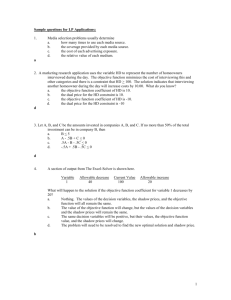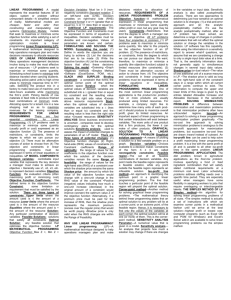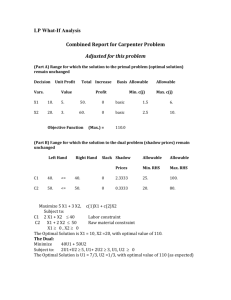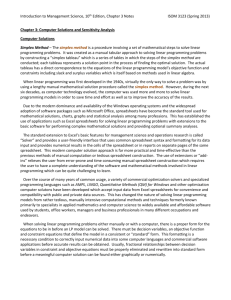Past First Exams (Word)
advertisement
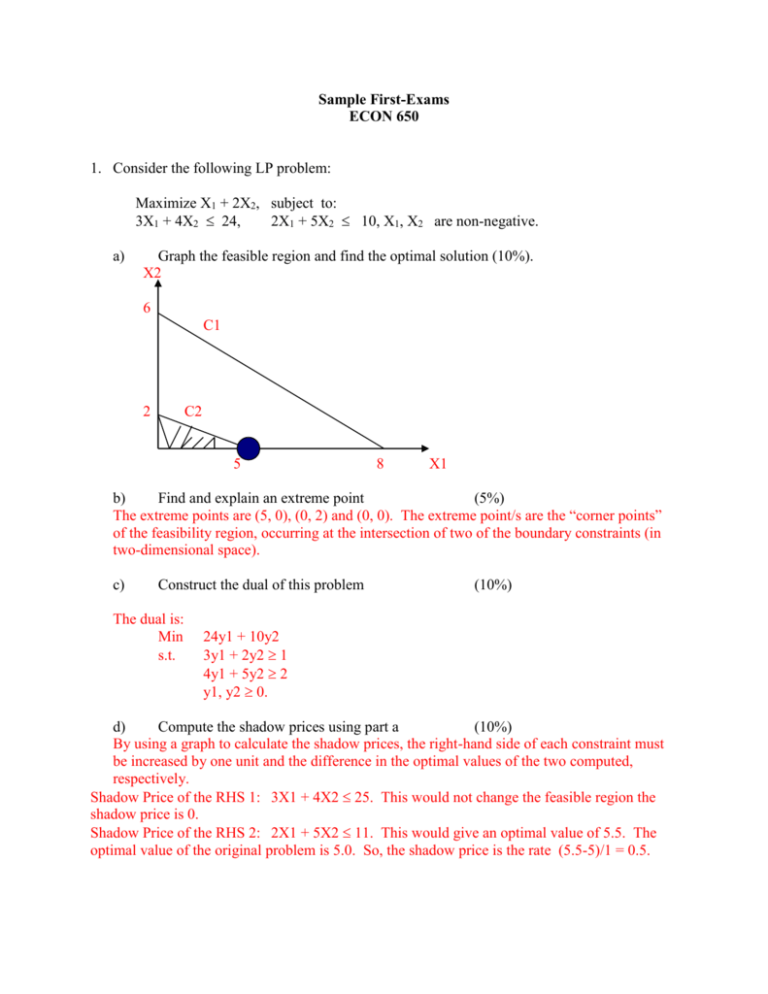
Sample First-Exams ECON 650 1. Consider the following LP problem: Maximize X1 + 2X2, subject to: 3X1 + 4X2 24, 2X1 + 5X2 10, X1, X2 are non-negative. a) Graph the feasible region and find the optimal solution (10%). X2 6 C1 2 C2 5 8 X1 b) Find and explain an extreme point (5%) The extreme points are (5, 0), (0, 2) and (0, 0). The extreme point/s are the “corner points” of the feasibility region, occurring at the intersection of two of the boundary constraints (in two-dimensional space). c) Construct the dual of this problem The dual is: Min s.t. (10%) 24y1 + 10y2 3y1 + 2y2 1 4y1 + 5y2 2 y1, y2 0. d) Compute the shadow prices using part a (10%) By using a graph to calculate the shadow prices, the right-hand side of each constraint must be increased by one unit and the difference in the optimal values of the two computed, respectively. Shadow Price of the RHS 1: 3X1 + 4X2 25. This would not change the feasible region the shadow price is 0. Shadow Price of the RHS 2: 2X1 + 5X2 11. This would give an optimal value of 5.5. The optimal value of the original problem is 5.0. So, the shadow price is the rate (5.5-5)/1 = 0.5. e. If the right end side of constraint 1 is increased by 1, what would be the consequence on the optimal value? (10%) There is no effect on the optimal value. It remains 5.0 because constraint #1 is not binding. This is also reflected in the fact that the shadow price for constraint #1 is 0. 2. Palmgard International makes two products: inner glove and STS batting glove. Profit is $5 for the inner glove and $7 for the STS batting glove. The inner glove requires 1.5 sq. ft. of leather and 6 inches of foam while the STS batting glove requires 1 sq. ft of leather and 4 inches of foam. Palmgard receives 500 sq. ft of leather and 175 ft. of foam each day for production. It takes 6 minutes to construct an inner glove and 4 minutes to construct an STS batting glove and there are 80 hours available each day. Palmgard requires that at least 275 inner gloves are made daily. Set up the Linear Program model (do not solve it). (10%) Decision Variables are: X1 = Number of inner glove made daily X2 = Number of STS batting gloves made daily Maximize daily profit 5X1 + 7X2 s.t. 1.5X1 + X2 500 (leather) 6X1 + 4X2 2100 (foam) 6X1 + 4X2 4800 (labor) X1 275 (production) X1, X2 0. 3. Pick any two of the following key words and phrases, and explain each one in a short paragraph: (10%) Management Science: Management Science is a rational, structured approach to problem solving. It is the study of developing procedures that can be used in the process of decision making and planning. Management Science provides systematic and general approaches to problem solving and decision making that are based on mathematical modeling, simulation, and logical reasoning. MS provides a quantitative evaluation of alternative policies, plans and decision giving a decision maker information to make a better decision. Problem understanding, finding a satisfactory solution, and control the problem are the main parts of management Science activities. Sensitivity Analysis: Sensitivity analysis is performed after the optimal solution is derived to determine how sensitive the optimal solution/optimal value is to changes in one or more of the input parameters or to other changes such as the addition or elimination of constraints or variables. In performing sensitivity analysis, the following items are analyzed: shadow prices, ranges of for which shadow prices remain unchanged, and ranges of optimality (i.e., optimal solution remains unchanged). Some of the uses of sensitivity analysis include: identify critical values where the optimal strategy changes; identify sensitivity (robustness) of important variables; develop flexible recommendations that depend on different scenarios; and assessment of the “what-if” scenarios. Shadow Prices: The shadow price for a constraint measures the amount the objective function optimal value changes per unit increase in the right-hand side value of the constraint. Therefore, the shadow price is “a rate of change” known also as the marginal value of the RHS. The shadow price for nonbinding constraint is always 0. For example, if the shadow price for a constraint is 2, this means that for every unit the RHS of that constraint is increased, the optimal value increases by 2. So, if the RHS of that constraint increases 2 units then the optimal value will increase by 4. All these are correct given the change on the RHS is within its sensitivity range, otherwise the shadow price is not valid. Binding Constraint: A binding constraint is a constraint that is satisfied with equality at the optimal point. A constraint is nonbinding if it is not satisfied with equality at the optimal point. In a practical sense, a binding constraint effects the optimal solution because it places a limit (upper or lower) on the optimal solution. For example, in problem #1 of this exam, the constraint 2X1 + 5X2 10 is a binding constraint because it limits the optimal solution and the optimal point (5, 0) satisfies the equation with equality. Slack: Slack is associated resource constraints, i.e., with constraints. Slack is the amount of a resource that is left over and it is found by subtracting the value of the left side of the constraint (determine this value by inserting a value for X1 and X2, etc.) from the constant on the righthand side. If the values for X1 and X2, etc. satisfy the constraint with equality, then the slack is zero because all of the resource is used. Slack can only be nonnegative, never negative. Dual Problem: The dual problem is closely related to the primal problem and the dual can be constructed from the primal problem. The solution to the dual problem provides shadow prices for the RHS of the constraints of the primal problem, and vice versa. Economical equilibrium exists between a primal and a dual problem which means that the optimal value for both problems is the same. By performing sensitivity analysis on the objective function of the dual problem, the sensitivity range for the right-hand side values for the constraints in the primal problem can be determined, and vice versa. 4. Name a former president of the United States who is not buried in the USA. (5%) This is a problem understanding question. “Clinton” is a solution. 5. Given the LP problem: Maximize Z = 3X1 + 5X2, subject to: X1 + 2X2 50, -X1 + X2 10, X1 0 X2 0, and the following Lindo output (50%) OBJECTIVE FUNCTION VALUE 1) 130.0000 VARIABLE X1 X2 VALUE 10.000000 20.000000 SLACK/ SURPLUS 0.000000 0.000000 REDUCED COST 0.000000 0.000000 DUAL PRICES 2.666667 -0.333333 OBJ COEFFICIENT RANGES VARIABLE CURRENT ALLOWABLE COEF INCREASE X1 3.000000 INFINITY X2 5.000000 1.000000 ALLOWABLE DECREASE 0.500000 8.000000 RIGHTHAND SIDE RANGES CURRENT RHS 50.000000 10.000000 ALLOWABLE INCREASE INFINITY 15.000000 ALLOWABLE DECREASE 30.000000 60.000000 Answer the following questions: 1 - What is the optimal solution and optimal value for the problem? The optimal solution X1 = 10, X2 = 20, and the optimal value is $130. 2 - Which of the constraints are binding? The binding constraints are X1 + 2X2 50, -X1 + X2 10. 3 - What is the impact on the optimal solution and optimal value if we decrease the cost coefficient C1=3 to 2.6? Why? There is no impact on the optimal solution if we decrease the cost coefficient from 3 to 2.6 because the amount of change is within its sensitivity rang of this cost coefficient. However, the new optimal value is 2.6(10) + 5(20) = 126 a decrease of $4 in total net profit. 4 - What is the shadow price for the RHS # 1.? How do you interpret it? The shadow price for the RHS #1 is 2.67 and will increase (decrease) in profit by $ 8/3 per unit increase (decrease) within the RHS#1 sensitivity range. 5 - What is the shadow price for the RHS # 2? How do you interpret it? The shadow price for the RHS #2 is -0.33 and will decrease (increase) in profit -0.33 per unit increase (decrease) within the RHS#2 sensitivity range. 6 - What is the impact on the optimal value if we decrease the right-hand side of constraint 1 by 5. The impact on the optimal value if we decrease the righ-hand side of constraint 1 by 5 is a decrease of 5($8/3) = $13.33. 7 - What is the impact on the optimal value if we increase the right-hand side of constraint 2 by 5? The impact on the optimal value if we increase the right-hand side of constraint 2 by 5 reduction is increase in profit by 5($1/3). 8 - Is it profitable to produce a new product with net profit of $16 requiring only 6 units of resource #1? Why? If we produce the new product it costs us 6(shadow price) = 6 ($8/3) = $16, since the net profit is also $16, therefore it is not profitable to produce the new product. 9 - What is the impact of deleting the second constraint on the optimal solution? Why? Because this constraint is a binding constraint the impact of deleting the second constraint of the optimal solution will require resolving the problem. 10- What is the impact of adding the following new constraint X2 + 5X1 = 60 on the optimal solution? Why? The impact of adding this new constraint on the optimal solution is the solution will be worse (smaller) than the original optimal solution, because the current solution does not satisfy this new constraint. 6. Solve the following problem: Maximize X1 + 2X2 + 3X3 Subject to: 4X1 + 2X2 + 3X3 24, all variables Xi's 0 (10%) Since the feasible region is bounded, one may apply the Algebraic Method. There is only one constraint; therefore at most one variable may take a positive value the rest must be set to zero: X1 X2 X3 feasible? Objective value ___________________________________________ 0 0 8 yes 24 0 12 0 yes 24 6 0 0 yes 6 0 0 0 yes 0 Therefore the problem has multiple solutions at vertices (0, 0, 8), (0, 12, 0) and any point on the line segment joining these two vertices. Freda Fitness is expanding her personal training business by opening another gym location. She has three possible sites from which to choose. Freda has found that her business success follows the trend in the nutrition industry, which is expanding, stable, or declining. Given each trend, her expected profit/loss in the first year of operation for each site is shown below: (20%) Site 1 Site 2 Site 3 Expanding 50000 100000 80000 Stable 20000 50000 60000 Decline 0 -40000 10000 a. If Freda is an optimist and wishes to maximize her maximum profit, which site should she choose using the maximax approach? (10%) MAXIMAX Site 1 Site 2 Site 3 maximum payoff 50,000 100,000 80,000 maximax value She should choose site 2. b. If Freda is a pessimist but wishes to minimize her regret, what site should she choose using the minimax regret approach? (10%) b. Under the minimax regret approach, Freda determines the maximum regret for each decision alternative by creating a regret table and then chooses the one which has the minimum maximum regret. The regret table for this decision is shown below: Site 1 Site 2 Site 3 MINIMAX REGRET Site 1 Site 2 Site 3 Expanding 50,000 0 20,000 Stable 40,000 10,000 0 maximum regret 50,000 50,000 20,000 Declining 10,000 50,000 0 minimax regret value Here, the maximum regret for Site 1 is $50,000; $50,000 for Site 2 and $20,000 for Site 3. The site with the minimum maximum regret is Site 3 so Freda should select this site. 4. Continuation of problem No. 3, Based on long-term trends in the nutrition industry, Freda projects the following probabilities for the state of the industry: Expanding 30% Stable 50% Declining 20% (15%) a. Given these probabilities, what decision should Freda make to maximize her expected profit? Given probability estimates for the states of nature, an expected value can be calculated for each decision alternative by multiplying the probability for each state of nature by the associated return and then summing these products. To maximize expected profit, Freda should choose the decision alternative with the best expected value. The expected value of each decision alternative is as follows: Site 1 = .3(50,000) + .5(20,000) + .2(0) = Site 2 = .3(100,000) + .5(50,000) + .2(-40,000) = Site 3 = .3(80,000) + .5(60,000) + .2(10,000) = 25,000 47,000 56,000 The site with the highest expected value is Site 3 so Freda should select this site. 5. The CNN wants to market a new series program, whose success probability was estimated to be 0.80. Suppose a marketing research agency is hired to evaluate the program. The past experience indicates that the agency has 90% of accuracy in predicting a success and 80% of accuracy in predicting a failure. What is the probability that the program is successful given a favorable prediction? What is the probability that the program is a failure given an unfavorable prediction? (15%) Positive prior conditional joint posterior Successful Unsuccessful .80 .20 .90 .20 .72 .04 .76 .72/.76 = .95 .04/.76 = .05 Negative UNFAVORABLE Successful Unsuccessful prior .80 .20 conditional .10 .80 joint .08 .16 .24 posterior .08/.24 = .33 .16/.24 = .67 FAVORABLE


